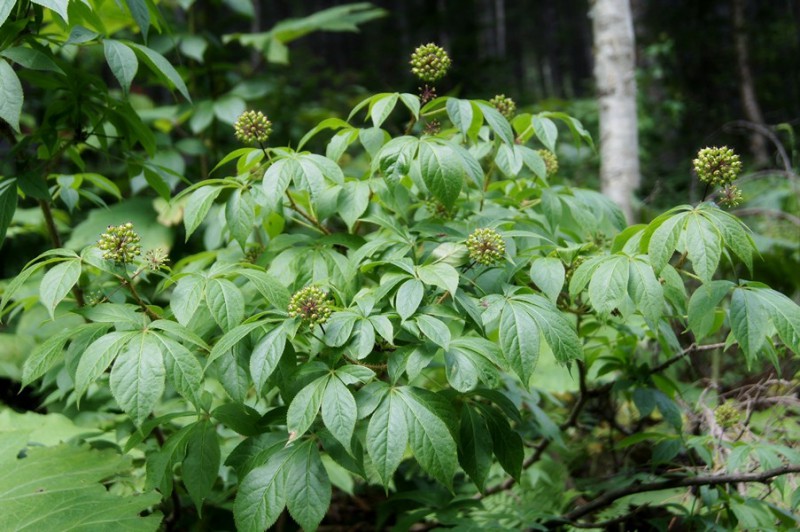Eleutherococcus senticosus (Rupr. & Maxim.) Maxim. - syn. Acanthopanax senticosus (Rupr. & Maxim.) Harms; Hedera senticosa Rupr. & Maxim. - Araliaceae
Siberian ginseng, 刺五加 ci wu jia (chin.), Sibirischer Ginseng, (Borstige) Taigawurzel, Borstige Fingeraralie, Stachelpanax
Deciduous shrub, up to 6m tall, native to Northeastern Asia (Russian Far East, China, Korea, Japan); branches with bristlelike prickles; leaves long-stalked (3-12cm), palmate, leaflets (3-)5, elliptic-obovate or oblong, 5-13, abaxially pubescent on veins, adaxially with scattered hairs; inflorescence terminal, a solitary or compound umbel, borne on leafy shoots, usually with 2-6 umbels together; corolla purple-yellow; fruit ovoid-globose, ca.8mm in diam. http://www.efloras.org/florataxon.aspx?flora_id=2&taxon_id=220004653
„An inventory of the secondary substances contained in Eleutherococcus discloses a potential for a wide range of activities reported from work on cultured cell lines, small laboratory animals and human subjects… Six compounds show various levels of activity as anti-oxidants, four show anti-cancer action, three show hypocholesterolemic activity, two show immunostimulatory effects, one has choleretic activity and one has the ability to decrease/moderate insulin levels, one has activity as a radioprotectant, one shows anti-inflammatory and anti-pyretic activities and yet another has shown activity as an antibacterial agent. Some of the compounds show more than one pharmacological effect and some show similar effects although they belong to different chemical classes… Also, comparison of Eleutherococcus with the more familiar Panax ginseng C.A. Meyer (Araliaceae), ‘true ginseng’ has underscored that they differ considerably chemically and pharmacologically and cannot be justifiably considered as mutually interchangeable.“
[Eleutherococcus senticosus (Rupr. & Maxim.) Maxim.(Araliaceae) as an adaptogen: a closer look., Davydov, M., Krikorian, A.D., Journal of Ethnopharmacology, 72(3), 2000, 345-393] http://heavenearth.com.au/docs/Siberian%20Ginseng%20Adaptogenic.pdf
„A clinical trial was undertaken to investigate the effects of Eleutherococcus senticosus (ES) and Panax ginseng (PG) on competitive club-level endurance athletes engaged in their normal in-season training… No significant change in testosterone, cortisol or TCR was observed in the PG group. In the ES group, however, TCR decreased by 28.7% from 0.0464 to 0.0331 (P=0.03). The main contribution to this decrease appeared to be a non-significant (P= 0.07) 31% trend towards increased cortisol rather than a very small non-significant (P= 0.36) 7% decrease in the calculated mean for testosterone. This result suggested that contrary to initial expectation, ES increased rather than decreased hormonal indices of stress, which may be consistent with animal research suggesting a threshold of stress below which ES increases the stress response and above which ES decreases the stress response.“
[The effects of Eleutherococcus senticosus and Panax ginseng on steroidal hormone indices of stress and lymphocyte subset numbers in endurance athletes., Gaffney, B.T., Hügel, H.M., Rich, P.A., Life sciences, 70(4), 2001, 431-442]
The roots are a commonly used ginseng substitute in Russia, China and Korea. The drug (Eleutherococci radix, Rhizoma et radix Eleutherococci, корневище и корень элеутерококка колючего, Taigawurzel) was introduced to modern medicine by scientists of the Soviet Union in the second half of the 20th century. The effects are described as immune stimulating/modulating, anabolic, and adaptogen. Ingredients from different chemical groups have been called eleutherosides: lignans like sesamin (eleutheroside B4) and syringaresinol (eleutheroside E), phenylpropane derivatives like the sinapyl alcohol glucoside syringin (eleutheroside B, 0.1-0.5%), coumarines like the 7-O-glucisde of isofraxidin (eleutheroside B1), and triterpene saponins (0.125%, eleutherosides I-M), and sugars like methyl-α-D-galactoside (eleutheroside C).
[Wolfgang Blaschek ed., Wichtl - Teedrogen und Phytopharmaka: Ein Handbuch für die Praxis, 2015, 234-236]

Eleutherococcus senticosus (Siberian-ginseng -Элеутерококк )
CC BY-SA 2.0, Author: Tatters https://www.flickr.com/photos/tgerus/8654220985
